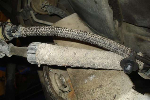Daniel V
Member
- Joined
- November 1, 2018
- Messages
- 24
- Reaction score
- 2
- City, State
- Tonasket WA
- Year, Model & Trim Level
- 2000 Explorer XLT
2000 4.0 SOHC XLT 224K Miles.
Using the cruise control on the way home from work and it started to decelerate. Tapped the gas and everything seemed fine. Stopped at the store and the idle started dropping below 500rpms. I checked the oil after getting out of the store and it was fine. About six miles down the road and after a big hill started losing power and the oil pressure gauge started going nuts. Shut it down and pulled off the road.
I didn't hear any gnarly noises while this was happening. The temp gauge was at 1/2 like it always is. I'm a few hundred over due for an oil change and I did not change the filter last time (couldn't get the sucker off)but the mobil1 I use says good for 10k so I thought another 3k would be alright. It was about 105 out today.
Any thoughts on what direction to start it would be great.
Thanks.
Using the cruise control on the way home from work and it started to decelerate. Tapped the gas and everything seemed fine. Stopped at the store and the idle started dropping below 500rpms. I checked the oil after getting out of the store and it was fine. About six miles down the road and after a big hill started losing power and the oil pressure gauge started going nuts. Shut it down and pulled off the road.
I didn't hear any gnarly noises while this was happening. The temp gauge was at 1/2 like it always is. I'm a few hundred over due for an oil change and I did not change the filter last time (couldn't get the sucker off)but the mobil1 I use says good for 10k so I thought another 3k would be alright. It was about 105 out today.
Any thoughts on what direction to start it would be great.
Thanks.










